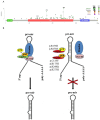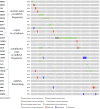Deregulation mechanisms and therapeutic opportunities of p53-responsive microRNAs in diffuse large B-cell lymphoma
- PMID: 39802185
- PMCID: PMC11720970
- DOI: 10.7717/peerj.18661
Deregulation mechanisms and therapeutic opportunities of p53-responsive microRNAs in diffuse large B-cell lymphoma
Abstract
Here, we have discussed the molecular mechanisms of p53-responsive microRNAs dysregulation in response to genotoxic stress in diffuse large B-cell lymphoma (DLBCL) patients. The role of micro ribonucleic acids (microRNAs) in p53-signaling cellular stress has been studied. MicroRNAs are the small non-coding RNAs, which regulate genes expression at post-transcriptional level. Many of them play a crucial role in carcinogenesis and may act as oncogenes or suppressor of tumor growth. The understanding of the effect of p53-responsive microRNA dysregulation on oncogenesis achieved in recent decades opens wide opportunities for the diagnosis, prediction and of microRNA-based cancer therapy. Development of new bioinformatics tools and databases for microRNA supports DLBCL research. We overview the studies on the role of miRNAs in regulating gene expression associated with tumorigenesis processes, with particular emphasis on their role as tumor growth-suppressing factors. The starting point is a brief description of the classical microRNA biogenesis pathway and the role of p53 in regulating the expression of these molecules. We analyze various molecular mechanisms leading to this dysregulation, including mutations in the TP53 gene, DNA methylation, changes in host-genes expression or microRNA gene copy number, mutations in microRNA and microRNA biogenesis genes.
Keywords: Diffuse Large B-cell Lymphoma (DLBCL); Gene expression; microRNA regulation; microRNA-based cancer therapy; p53 response elements.
©2025 Voropaeva et al.
Conflict of interest statement
Yuriy L. Orlov is an Academic Editor for PeerJ.
Figures



References
-
- Ashrafizadeh M, Zarrabi A, Orouei S, Kiavash H, Hakimi A, Amirhossein Z, Daneshi S, Samarghandian S, Baradaran B, Najafi M. MicroRNA-mediated autophagy regulation in cancer therapy: the role in chemoresistance/chemosensitivity. European Journal of Pharmacology. 2021;892:173660. doi: 10.1016/j.ejphar.2020.173660. - DOI - PubMed
-
- Asmar F, Hother C, Kulosman G, Treppendahl MB, Nielsen HM, Ralfkiaer U, Pedersen A, Møller MB, Ralfkiaer E, De Nully Brown P, Grønbæk K. Diffuse large B-cell lymphoma with combined TP53 mutation and MIR34A methylation: another double hit lymphoma with very poor outcome? Oncotarget. 2014;5(7):1912–1925. doi: 10.18632/oncotarget.1877. - DOI - PMC - PubMed
-
- Aya-Bonilla C, Green MR, Camilleri E, Benton M, Keane C, Marlton P, Lea R, Gandhi MK, Griffiths LR. High-resolution loss of heterozygosity screening implicates PTPRJ as a potential tumor suppressor gene that affects susceptibility to Non-Hodgkin’s lymphoma. Genes Chromosomes Cancer. 2013;52(5):467–479. doi: 10.1002/gcc.22044. - DOI - PubMed
Publication types
MeSH terms
Substances
LinkOut - more resources
Full Text Sources
Research Materials
Miscellaneous

